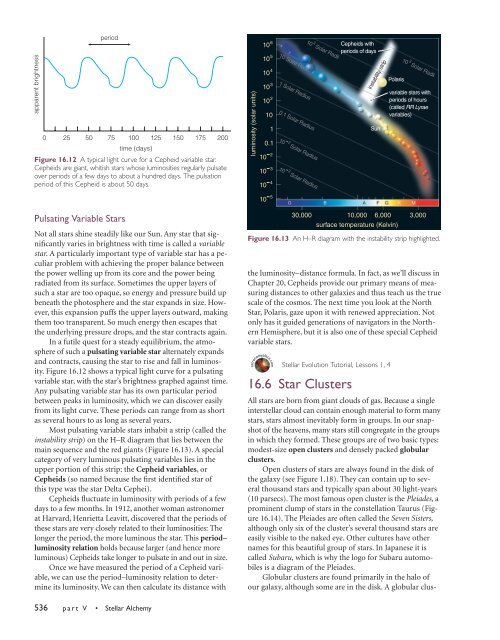Chapter 16--Properties of Stars
Chapter 16--Properties of Stars
Chapter 16--Properties of Stars
Create successful ePaper yourself
Turn your PDF publications into a flip-book with our unique Google optimized e-Paper software.
apparent brightness<br />
period<br />
0 25 50 75 100 125 150 175 200<br />
Pulsating Variable <strong>Stars</strong><br />
time (days)<br />
Figure <strong>16</strong>.12 A typical light curve for a Cepheid variable star.<br />
Cepheids are giant, whitish stars whose luminosities regularly pulsate<br />
over periods <strong>of</strong> a few days to about a hundred days. The pulsation<br />
period <strong>of</strong> this Cepheid is about 50 days.<br />
Not all stars shine steadily like our Sun. Any star that significantly<br />
varies in brightness with time is called a variable<br />
star. A particularly important type <strong>of</strong> variable star has a peculiar<br />
problem with achieving the proper balance between<br />
the power welling up from its core and the power being<br />
radiated from its surface. Sometimes the upper layers <strong>of</strong><br />
such a star are too opaque, so energy and pressure build up<br />
beneath the photosphere and the star expands in size. However,<br />
this expansion puffs the upper layers outward, making<br />
them too transparent. So much energy then escapes that<br />
the underlying pressure drops, and the star contracts again.<br />
In a futile quest for a steady equilibrium, the atmosphere<br />
<strong>of</strong> such a pulsating variable star alternately expands<br />
and contracts, causing the star to rise and fall in luminosity.<br />
Figure <strong>16</strong>.12 shows a typical light curve for a pulsating<br />
variable star, with the star’s brightness graphed against time.<br />
Any pulsating variable star has its own particular period<br />
between peaks in luminosity, which we can discover easily<br />
from its light curve. These periods can range from as short<br />
as several hours to as long as several years.<br />
Most pulsating variable stars inhabit a strip (called the<br />
instability strip) on the H–R diagram that lies between the<br />
main sequence and the red giants (Figure <strong>16</strong>.13). A special<br />
category <strong>of</strong> very luminous pulsating variables lies in the<br />
upper portion <strong>of</strong> this strip: the Cepheid variables,or<br />
Cepheids (so named because the first identified star <strong>of</strong><br />
this type was the star Delta Cephei).<br />
Cepheids fluctuate in luminosity with periods <strong>of</strong> a few<br />
days to a few months. In 1912, another woman astronomer<br />
at Harvard, Henrietta Leavitt, discovered that the periods <strong>of</strong><br />
these stars are very closely related to their luminosities: The<br />
longer the period, the more luminous the star. This period–<br />
luminosity relation holds because larger (and hence more<br />
luminous) Cepheids take longer to pulsate in and out in size.<br />
Once we have measured the period <strong>of</strong> a Cepheid variable,<br />
we can use the period–luminosity relation to determine<br />
its luminosity. We can then calculate its distance with<br />
536 part V • Stellar Alchemy<br />
luminosity (solar units)<br />
10 6<br />
10 5<br />
10 4<br />
10 3<br />
10 2<br />
10<br />
10 2<br />
Figure <strong>16</strong>.13 An H–R diagram with the instability strip highlighted.<br />
the luminosity–distance formula. In fact, as we’ll discuss in<br />
<strong>Chapter</strong> 20, Cepheids provide our primary means <strong>of</strong> measuring<br />
distances to other galaxies and thus teach us the true<br />
scale <strong>of</strong> the cosmos. The next time you look at the North<br />
Star, Polaris, gaze upon it with renewed appreciation. Not<br />
only has it guided generations <strong>of</strong> navigators in the Northern<br />
Hemisphere, but it is also one <strong>of</strong> these special Cepheid<br />
variable stars.<br />
astronomyplace.com<br />
1<br />
0.1<br />
10 3<br />
10 4<br />
10 5<br />
10 Solar Radii<br />
1 Solar Radius<br />
0.1 Solar Radius<br />
10 2 Solar Radius<br />
10 3 Solar Radius<br />
10 2 Solar Radii<br />
Stellar Evolution Tutorial, Lessons 1, 4<br />
<strong>16</strong>.6 Star Clusters<br />
Cepheids with<br />
periods <strong>of</strong> days<br />
instability strip<br />
All stars are born from giant clouds <strong>of</strong> gas. Because a single<br />
interstellar cloud can contain enough material to form many<br />
stars, stars almost inevitably form in groups. In our snapshot<br />
<strong>of</strong> the heavens, many stars still congregate in the groups<br />
in which they formed. These groups are <strong>of</strong> two basic types:<br />
modest-size open clusters and densely packed globular<br />
clusters.<br />
Open clusters <strong>of</strong> stars are always found in the disk <strong>of</strong><br />
the galaxy (see Figure 1.18). They can contain up to several<br />
thousand stars and typically span about 30 light-years<br />
(10 parsecs). The most famous open cluster is the Pleiades, a<br />
prominent clump <strong>of</strong> stars in the constellation Taurus (Figure<br />
<strong>16</strong>.14). The Pleiades are <strong>of</strong>ten called the Seven Sisters,<br />
although only six <strong>of</strong> the cluster’s several thousand stars are<br />
easily visible to the naked eye. Other cultures have other<br />
names for this beautiful group <strong>of</strong> stars. In Japanese it is<br />
called Subaru, which is why the logo for Subaru automobiles<br />
is a diagram <strong>of</strong> the Pleiades.<br />
Globular clusters are found primarily in the halo <strong>of</strong><br />
our galaxy, although some are in the disk. A globular clus-<br />
Sun<br />
Polaris<br />
surface temperature (Kelvin)<br />
10 3 Solar Radii<br />
variable stars with<br />
periods <strong>of</strong> hours<br />
(called RR Lyrae<br />
variables)<br />
30,000 10,000 6,000 3,000
















